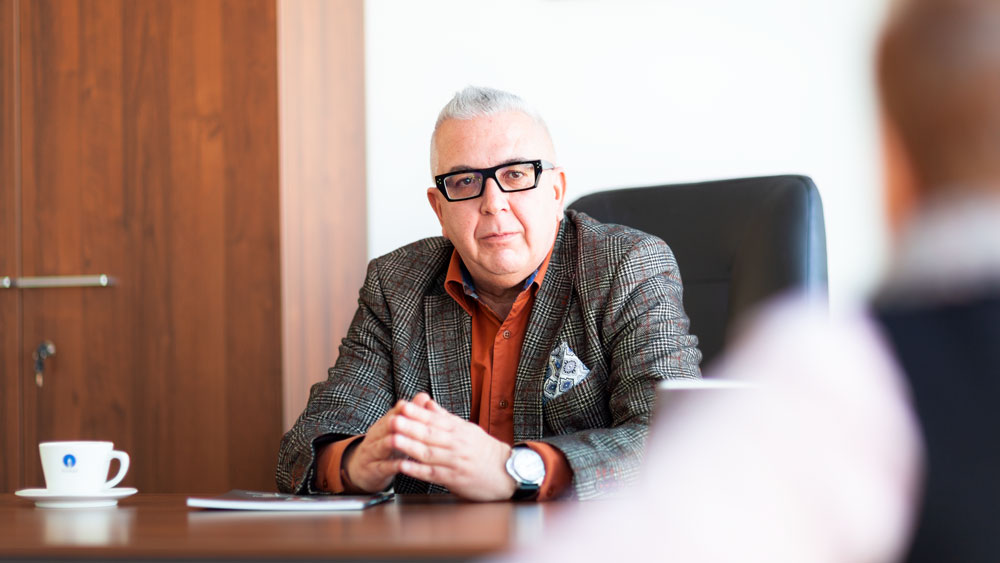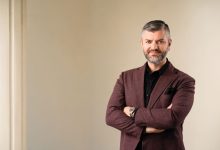Adrian Constantin Volintiru talks about the best energy mix for years to come
Today, Romgaz is in the top of transactions, and the price per share has increased by 15% compared to the offering price. We are reviewing, together with CEO Adrian Constantin Volintiru, the main milestones of the evolution and future development directions of the company.
The largest gas producer and main gas supplier in Romania celebrated, at the end of last year, five years since its listing on the Bucharest Stock Exchange (BSE), as well as on the London Stock Exchange. This was one of the largest offerings for shares conducted by the Romanian state through BSE. Starting 2013, the company’s shares have been traded on the regulated market managed by BSE under the symbol SNG and on the main market for listed financial instruments of LSE (London Stock Exchange), as Global Depositary Receipts (GDRs) issued by the Bank of New York Mellon under the symbol SNGR.
Dear Mr. Adrian Constantin Volintiru, your career path covers the entire chain of activities in the energy sector, from Upstream to Downstream, both in the state area and in the area of private companies. What is currently your vision on the Romanian and European energy sector in the context of the action plan for fulfilling the sustainable development targets? What is Romgaz’s position in this landscape?
Romania currently has all premises to become a regional player in the energy sector. For this purpose, Romgaz aims to be an active, profitable and competitive player on the gas and power production market. The Romanian energy market could be integrated around 2019-2020 in the market of the European Union, in conditions in which the project of creating a common European energy policy will be accelerated.
Romgaz needs to find its role of important player on this market and a benchmark for European competitors.
A retrospective of the past five years from the moment of listing shows that Romgaz is in the top of transactions, and the price per share has increased by 15% compared to the IPO price. What are the most important benefits of listing on the capital market?
Adrian Constantin Volintiru: Romgaz listing on the Bucharest Stock Exchange and London Stock Exchange has been an important moment in the company’s history. Listing has increased the degree of transparency and communication with investors, the business environment and public in Romania and abroad.
Romgaz has assumed its responsibilities arising from the company’s listing, i.e. reporting and communicating the important events in the life of the company to the stock exchange.
We shouldn’t forget the image boost from which a listed company benefits. Institutional and individual investors, the press in general, the business environment monitor closely the company’s evolution and help enhancing the reputation, promoting and developing our business.
Last spring, in the margin of the SEE Upstream 2018 conference, Sorin Gal – Director General, National Agency for Mineral Resources, said that the potential of Romania’s onshore hydrocarbon reserves exceeded the potential of hydrocarbon reserves in the Black Sea. He also mentioned the discovery of the Caragele field, the largest hydrocarbon discovery of the Romanian state over the past 30 years. What is currently the production potential of Romgaz and the reserve replacement ratio?
Adrian Constantin Volintiru: Romgaz’s tendency is to increase gas production to ensure a fair price for the end-consumer. At the same time, we are considering replacing consumed reserves with new gas reserves. Fortunately, here the results are spectacular: at this moment the reserve replacement ratio is over 70%, with the assumption that in 2019 it will approach 100% in conditions in which the world replacement ratio is just 30%.
Caragele is the largest onshore gas field discovered over the past 30 years in Romania and the estimated reserve is around 25-27 billion cubic meters of gas.
The Caragele field delivers daily into the system 700,000 cubic meters of gas, and the tendency is to increase production by mid-December (the interview took place in early December 2018 – Ed.), to 1,000,000 cu m per day, with the completion and commissioning of the gathering pipeline of 16km. Depending on the results of research studies, the estimated daily production could increase as of 2020 to 1,700,000 cu m per day.
The investments proposed for next year in Caragele field consist of drilling 15 wells and surface technological installations at 10 wells, worth a total of around EUR 45mln.
The future exploration efforts are currently focused on planning and executing drilling for confirmation and potential increase in the volume of the estimated resource with investments of over EUR 100mln.
What does the program for 2019 include regarding rehabilitation works executed on mature fields and geological research works in exploration blocks in order to balance the natural decline of production? What are the areas of interest?
Adrian Constantin Volintiru: Romgaz annually makes sustained efforts to balance the natural decline of production through rehabilitation works executed both on mature fields and geological research works. Mature fields in the rehabilitation process are those ensuring about 45% of the company’s total gas production.
For 2019, the work program includes the performance of specific operations, such as interventions and repairs, with various degrees of complexity at the wells producing with difficulty.
As regards the exploration program for 2019, it will focus on drilling works in the blocks where Romgaz is titleholder in the Transylvanian basin and in the Moesian Platform.
What will Romgaz’s involvement be in 2019 in the offshore segment?
Adrian Constantin Volintiru: As it is known, Romgaz is associated through a Joint Venture Agreement, as non-operator, with a 12.2% interest together with Lukoil Overseas Atash VB (87.8%) in EX Trident Block, the deep area of the Black Sea.
We will continue in the following period, together with our partner, the exploration works started and we are analysing collaborations and opportunities of exploration and exploitation of offshore blocks in the Black Sea.
In terms of tapping gas resources, the Ministry of Energy aims – besides the development of the gas network for population or switching the power plants currently operating based on coal to gas – the revitalization of the petrochemical industry in Romania. What is in your opinion the optimal version for Romgaz – taking over a chemical fertilizers plant, the construction of a new one, the conclusion of a partnership etc.?
Adrian Constantin Volintiru: We cannot discuss yet about an optimal version.
We have started a market study and, depending on the outcome of this study, we will analyse all options we have and we will make a decision. We are still in the stage of analysis of opportunity.
However, we want to multiply gas value on the value chain and we are always thinking about diversification. The eloquent example in this regard is the investment in Iernut, our intention to continue with Mintia and, obviously, to identify new business opportunities, including investments in the petrochemical segment. Here, the discussion is about the modality of taking over certain plants already existing or starting Greenfield investments.
Depending on the outcome of the study I previously referred to, we will be able to make the most advantageous decision for the company.
An important objective of the European Commission is economy decarbonization, which means that in the future the focus will not be on the large hydrocarbon reserves, but on the technological solutions for integrating sustainable energy. Long-term investments will obviously be necessary, aimed at not only economy decarbonization, but also at creating a favourable framework for innovation, research and development in the clean energy field. How does Romgaz relate to the 3D’s (digitalization, decarbonization, decentralization) of transition to a clean energy? What new energy capacities do you consider?
Adrian Constantin Volintiru: Romgaz is already considering technological solutions for the integration of sustainable energy, and the economy decarbonization process and finding innovative solutions in the energy sector are part of the sustainable development strategy of the company.
The prefeasibility study is already completed and we have launched the tender for the technical and conceptual feasibility study for a new power plant, in Mintia (Hunedoara County). I would like to physically start this project in 2019. Mintia power plant should be similar to that in Iernut.
We recall that Romgaz is currently investing EUR 270mln (without VAT) in the construction of a power plant in Iernut (Mures County), with a capacity of 430MW, which will become operational in 2020.
We are also interested in green energy production, which means the diversification of Romgaz’s portfolio.
Currently, Romgaz does not have the proper know-how for this activity, so first of all we are analysing the market, then the opportunities and options we have, either Greenfield, or acquisition.
In fact, a renewable-natural gas energy mix seems the best solution for the years to come.
The advantages of a gas-renewable energy portfolio are multiple.
As production from renewable sources is intermittent, back-up is needed for it. After hydropower plants, gas-fired power plants can have the quickest reaction to balance the National Power System (NPS).
Thus, on the one hand, Romgaz will have the possibility to sell electricity packages at very advantageous prices (renewable energy, especially wind energy, is the cheapest).
What are the priority directions for Romgaz’s development for the following period? What are the sectors targeted by investments and what is the average rate of equity invested?
Adrian Constantin Volintiru: Romgaz will focus in the following period on finding onshore fields and on energy diversification.
Romgaz is consolidating its position not only domestically, but also at regional level, and will focus in the following period on two major objectives, i.e. finding onshore fields, to replace the current exploitation, and energy diversification.
We have as strategic development directions: wind power, compressed natural gas, a new power plant, the discovery of new fields and, last but not least, offshore operations in the Black Sea.
We are interested in the present and the future and I believe that only by investing massively in large scale projects can we become competitive at regional level and a trustworthy partner in this area of Europe.
In conclusion, Romgaz will take steps to fulfil both the objectives proposed in the development strategy of the company, and those in the national energy strategy, to act as a trustworthy partner in the region and, not least, act as a main player of cross-border cooperation to the benefit of all participants to the European energy market.
Regional cooperation is essential to identify the best solutions and projects, especially in terms of energy security. Ensuring interconnectivity provides the possibility of developing sustainable partnerships between the EU member states.
What future projects will you include on the agenda for 2019? Are there projects/partnerships of interest for Romgaz at European level? What signals do you have in this regard?
Adrian Constantin Volintiru: Currently, the Project ‘Development of Sarmasel gas storage facility’ was promoted on the 3rd list of PIC (Projects of Common Interest) of the European Union by S.N.G.N. Romgaz S.A.
In October 2018, steps were taken by S.N.G.N. Romgaz S.A. to be taken over by F.I.G.N. DEPOGAZ Ploiesti S.R.L. and Romgaz approved the takeover of the status of project promoter by DEPOGAZ. This was announced to the European Commission, the Ministry of Energy and ANRE.
You have a rich experience in the field of strategic planning and business flows optimization. What are, in your view, the ingredients of a successful business model on a competitive market?
Adrian Constantin Volintiru: Indeed, with the new market regulations, which favour higher competition between gas sources, Romgaz’s business model needs to consider elements such as flexibility in decision-making in the entire chain of operations carried out, in order to continuously adapt to market conditions, as well as to explore business development opportunities at strategic level.
Focusing on creating added value for the company and thus for shareholders remains a continuous concern of Romgaz in all activities carried out.
Priorities are to ensure gas production in a sustainable manner, through research projects, providing quality services to customers, within and in order to reach objectives including at government level.
Customer confidence, supply safety and compliance with all market conditions, competition are the decisive factors for building a long-term win-win partnership.
Not long ago, experts declared the beginning of the ‘Golden age of natural gas’ for mankind. Although gas is an important pillar of the energy mix and will still remain an important energy source, there are however a number of concerns in terms of the future role of gas in energy generation, given the new targets for carbon emissions, renewable energy and energy efficiency. How do you see the role of natural gas in the future, both in Romania and globally?
Adrian Constantin Volintiru: The role of natural gas will remain important both in Romania’s energy mix and, especially, in the global energy mix. At EU level, natural gas is a transition fuel that can support reaching the targets regarding the reduction of greenhouse gas emissions. We should not forget that natural gas is the fossil fuel with the lowest greenhouse gas emissions or, if you will, is the ‘greenest’ fossil fuel.







